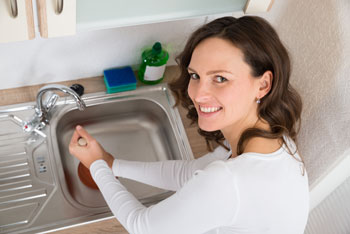 The humble plunger is a simple yet effective tool for breaking clogs in sinks, tubs and toilets. This handy tool is easy to use. You can make the most of its power if you understand how it works. Ready to dive in? Here’s what you need to know.
The humble plunger is a simple yet effective tool for breaking clogs in sinks, tubs and toilets. This handy tool is easy to use. You can make the most of its power if you understand how it works. Ready to dive in? Here’s what you need to know.
Safety First!
Never use a plunger with drain chemicals. Water will splash as you work, and the chemicals can spatter, burning skin and eyes. It’s a good idea to use rubber gloves and wear safety goggles when you work on a clog.
Choose the Right Tool for the Job
Plungers come in two different styles. Sinks, bathtubs and showers require a cup plunger. Like its name suggests, the rubber end is shaped like a cup. Use a flange plunger on toilets. These plungers have a rubber funnel extending from the cup. A plunger needs to be big enough to cover the drain.
Ready, Set, Plunge!
Whether you’re working on a sink, shower, tub or toilet, a plunger needs water to make a tight seal. A tight seal is required to chase out a clog. Make sure the bottom few inches of the cup is submerged. Remove excess water. Too much water will hinder work and make a mess. You can lay down rags or towels if you’re worried about water splashing on the floor or counter.
- Coat the rim: Coat the plunger rim with petroleum jelly. This helps make a better seal.
- Block outlets: Hold a wet rag over nearby outlets such as the overflow vent or the drain in a second sink.
- Release air: Insert the plunger at an angle into the water. Water will displace air in the cup. A water-filled cup is more forceful than one filled with air.
- Keep the plunger upright: Hold the plunger perpendicular to the drain. Use fast, forceful strokes, but make the first stroke gentle. The first stroke can create a splash if the cup still contains air. Thrust the plunger 15 to 20 times.
- Snap off the plunger: The final stroke should be a strong upward motion that ends when the plunger snaps off the drain.
- Repeat the process: you may need to repeat this sequence several times. When the water drains away, your work is done. High-five!
What Should You Do if the Drain Is Still Clogged?
Clogs that are unmoved by a plunger are stubborn indeed. More aggressive drain-clearing techniques can be tricky and hazardous. Chemicals, snakes and other devices require know-how. There’s no shame in calling a professional if plunging fails to fix what ails your drain.
Simpson Plumbing offers 24-hour emergency service in the Vancouver area. Give us a call at (360) 834-5311. Our friendly plumbers are ready to help!

 About Us
About Us  Services
Services  Plans
Plans  Commercial
Commercial